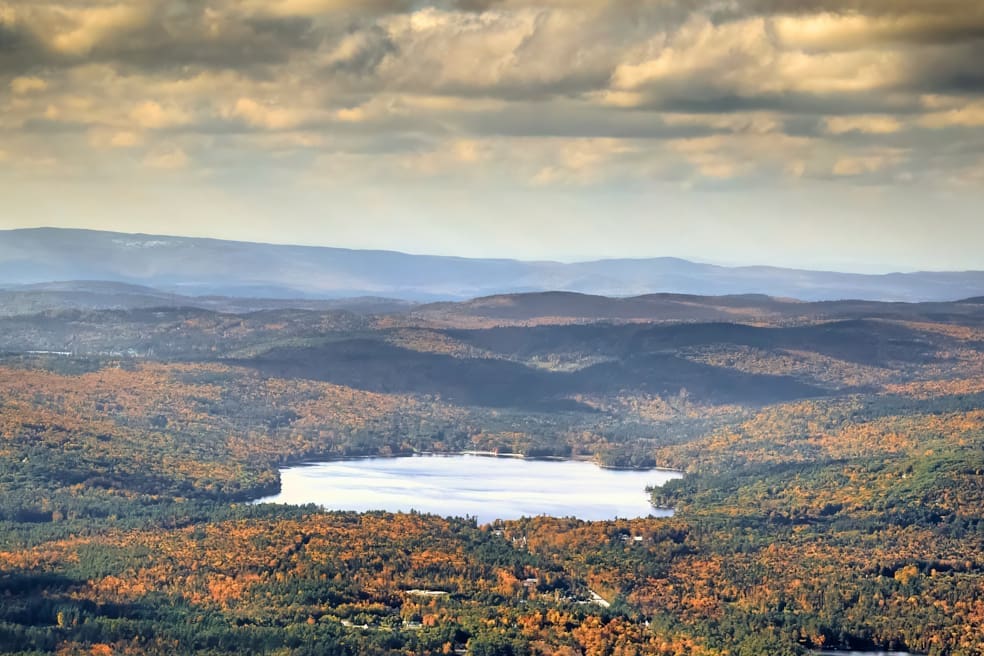Pleasant Lake Watershed Study

Colby Sawyer Student Project
Community Watershed Analysis: Pleasant Lake
Pleasant Lake is a deep oligotrophic lake with a long history of clear water and fine support for recreation and wildlife. As lakes age they change via natural processes and input from their surrounding watershed. Even Pleasant Lake is subject to an aging process, called eutrophication, that can move it towards more nutrient rich water and increased plant and algal growth that can lead to negative effects for water quality and wildlife.
The PLPA has monitored lake chemistry for years which provides us with a history of its water quality, but we need more information about what is flowing into the lake. This summer, with input from the PLPA, Colby Sawyer’s Environmental Science Program, under the direction of Prof. Nick Baer, began an important new Community-Based Research Project, “Community Watershed Analysis: Pleasant Lake”.
A main focus of the Colby Sawyer student’s project is on sources of phosphorous entering the Lake. This chemical is known to accelerate eutrophication and associated algal and cyanobacteria blooms. Phosphorus can enter lakes via stormwater sediments, agricultural runoff, fertilizer and septic failure. The students have been and will continue to collect and analyze water samples at select locations where water enters the Lake from its watershed.
More details on the project will follow the two important announcements below.
Colby Sawyer Student Project
Seeking Local Lake and Family History
Dryden Eliason is an environmental studies student and member of the community-based Pleasant Lake research project at Colby Sawyer College.
Dryden and a few of his classmates have been in contact with Jim Perkins at the New London Archives in search of historical data of Pleasant Lake and its surrounding watershed. They have found quite a bit of information about the agricultural practices in the past and even the development around the lake. They would love to hear the perspectives and voices of the people that have called the Pleasant Lake watershed home for generations. They are especially interested in family memories of when the roads were first paved, the development around the lake and old pictures.
Any present or past community members interested in sharing their historical perspectives about the lake and watershed are encouraged to contact Dryden at: dryden.eliason@my.colby-sawyer.edu
Colby Sawyer Student
Interim Presentation of the Project – December 7th
The students will give a public presentation of their findings during the first half of their two semester project.
December 7th at 5:30pm
Clements Hall in the Curtis L. Ivey Science Center.
A zoom link will be made available for anyone that cannot attend.
We will provide a reminder with more details as we get closer to the event.
Colby Sawyer Student Project
More about the Pleasant Lake Watershed Study

The PLPA Board feels this is an essential study that can set the stage for future more focused projects that will enhance our ability to protect Pleasant Lake for future generations. As such, we urge the community to help us and the Colby Sawyer students and faculty gather necessary background information. In return the project members will keep us informed of their progress and findings via newsletters and presentations.
Here is the Project Purpose Statement for the study:
“Colby-Sawyer College, in collaboration with the Pleasant Lake Protective Association (PLPA), will seek to improve the caliber and expanse of the existing water quality data, applying special attention to total phosphorus (TP), and identify the total loads of phosphorus from the lake’s tributaries. Pleasant Lake has experienced cyanobacteria blooms for the past two summers, which are fueled by excess phosphorus inputs into the system. Extended sampling will hope to pin-point areas of concern for excess nutrients in the watershed. We will raise awareness and provide education to local homeowners in relation to landscaping, stormwater management, and septic system maintenance through our data collection and communication with stakeholders. Such actions are integral in preserving the health and high water-quality of the lake.
In addition to the sampling, education, and communication initiatives, we will create comprehensive GIS maps that will illustrate the relationship between development and the Pleasant Lake watershed through the use of elevation models, septic system statuses, water chemistry analyses, tributary inflows, and stormwater inputs. These maps will visually display sampling locations and potential areas for concern.
Finally, we will present our analysis and findings to the PLPA, the Town of New London, and other stakeholders associated with the project. The project contains water sampling, chemical analyses, geographical analysis, education, outreach and communication. This information will help the PLPA and the Town of New London gain a more comprehensive understanding of the different parameters of the water quality in Pleasant Lake. Our findings will also help them to identify improvements that could be put in place to maintain the health of the lake and the surrounding watershed.”
Even those of us who do not live on the Lake are essential stewards for its protection and future.
